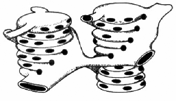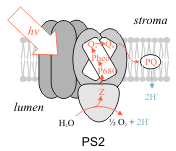The Photosynthetic Apparatus
Thylakoid membranes and electron transport

Fig. 1. A schematic model of two grana connected by a single stromal thylakoid. Image from Garab and Mustárdy, 1999.
Photosynthesis of green plants occurs in special organelles inside the plant cells called chloroplasts. The chloroplasts have double outer envelope and an inner system of interconnected membrane vesicles called thylakoids. They are usually arranged in stacks called grana (Fig. 1). All thylakoids constitute the thylakoid membrane, which divides the chloroplast into two separate volumes — the intrathylakoid space (lumen) and the surrounding stroma. The first phase of the photosynthetic process — the light reactions, which transform the light energy into chemical energy in the form of high-energy bonds of ATP and reduced NAPDH — takes place on the thylakoid membrane. The second phase — the dark reactions, which use the energy stored by the light reactions to convert CO2 into carbohydrates — occurs in the stroma.
The thylakoid membrane holds four transmembrane protein supercomplexes, namely Photosystem 1, Photosystem 2, the Cytochrome b6f complex, and the ATP-synthase. The photosystems are pigment-protein complexes containing chlorophyll. The chlorophyll molecules in their antennae trap the light quanta and drive an electron-transport chain which creates a difference between the proton concentration on both sides of the thylakoid membrane. This proton gradient is used by the ATP-synthase to convert ADP into the high-energy compound ATP.
Fig. 2. represents the linear electron transport in the thylakoid membrane according to the presently-accepted Z-scheme. The Photosystem 2 antenna delivers the light energy to a special chlorophyll — the PS2 reaction centre chlorophyll (P680). Upon excitation, it can donate an electron to the primary acceptor, pheophytin. The redox potential energy drives the electron further down the electron-transport chain — QA, QB, PQ, Cyt. b6f, PC, and PS1. The energy freed during this electron transport is used to transfer a proton from the stroma into the lumen. Thus, the proton gradient is generated.
The protons accumulated in the lumen of the thylakoid membrane pass through the ATP-synthase and generate ATP, which is the energetic currency of the living organisms. ATP's energy drives virtually all other energy-dependent processes in living organisms other than the primary processes of photosynthesis.
Upon arrival at the PS1 donor-side, the electron has lost its redox potential energy and another light quantum is needed for the PS1 reaction centre to push the electron further to the rest of the electron carriers. Finally, the electron is transfered to NADP and used in the dark phase of photosynthesis to reduce CO2.
Overall, the electrons in photosynthesis pass from Photosystem 2 via Cytochrome b6f and Photosystem 1 to NADP and carbohydrates. Photosystem 2 replenishes its lost electrons by splitting water. The water-splitting reaction yields, in addition to electrons, protons (which add to the proton gradient) and free oxygen that we can breathe, and is in fact the most energy-consuming reaction in the biosphere.
